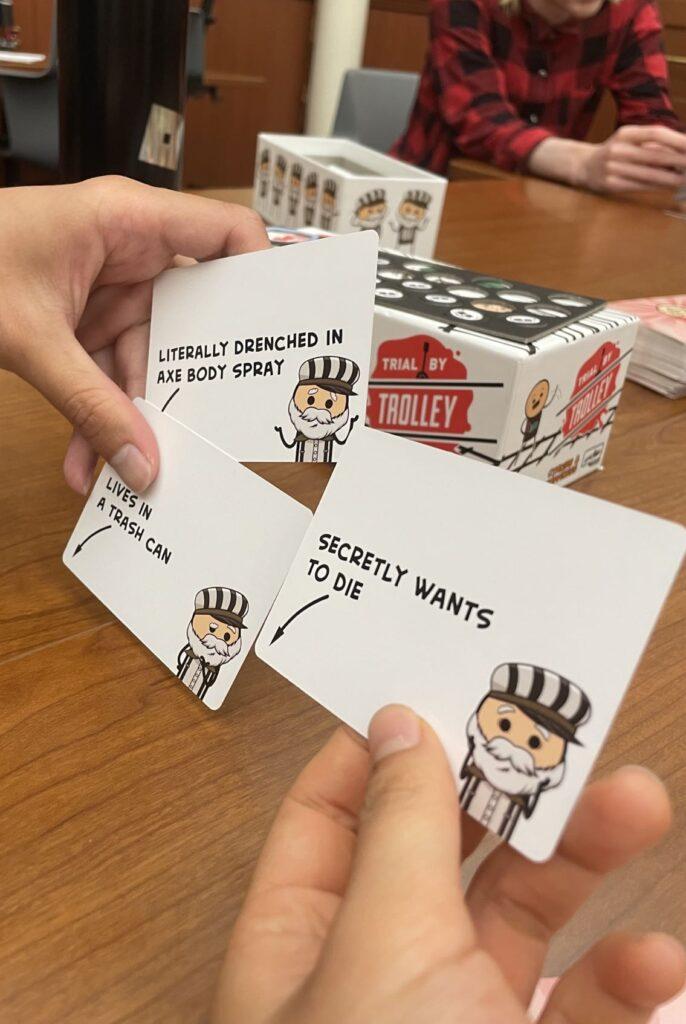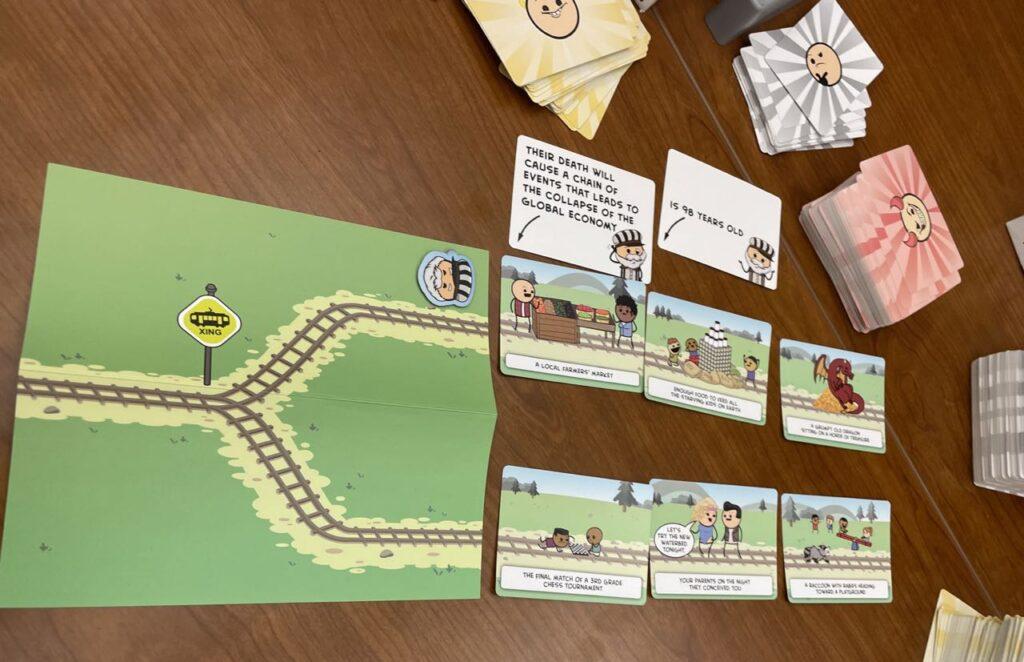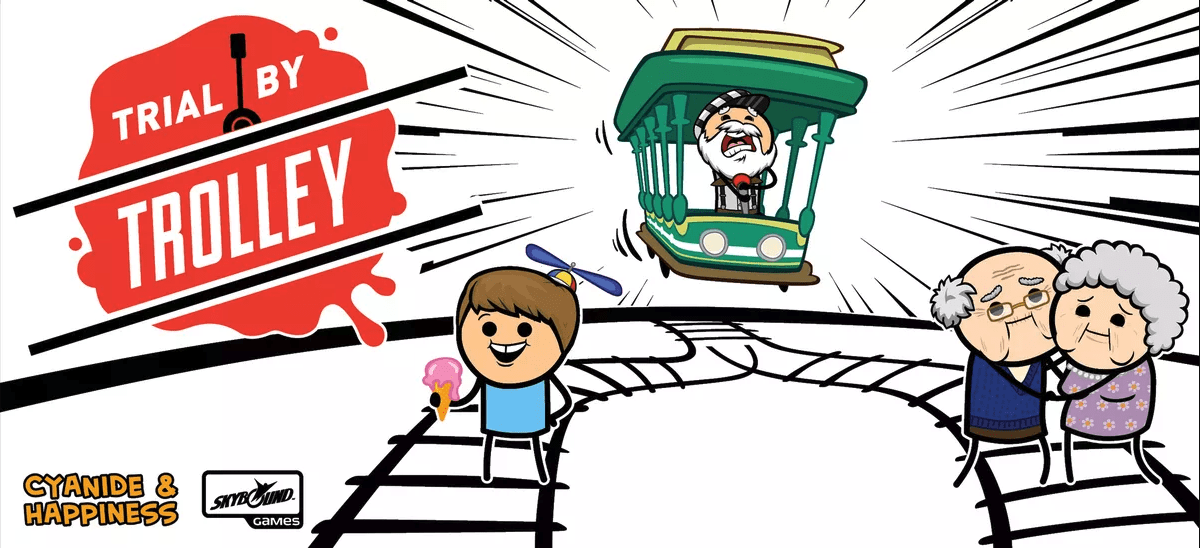Trial By Trolley employs judgment by compelling players to create crazy narratives, engage in controversial moral arguments, and make morally dubious decisions, all of which are subject to the judgments of others, fostering the aesthetics of narrative and fellowship.
Trial By Trolley is a board game designed by Scott Houser under the company Skybound, targeting groups of 3 to 13 teenagers and adults (recommended for ages 14+). It can be played using the physical game box and is available online. I played the physical version with a group of 7.
Each player alternates in the role of team member and judge. Judging is incorporated in both roles through mechanics of decision making and debate, dynamic of conflict and conflict resolution, and aesthetics of fellowship and narrative.
As a team member, the player is judged throughout the team decision-making process, where they must persuade their teammate whom the judge is more likely to kill. With a team-versus-team mechanic, the game’s objective is to have the judge choose to kill the opposing side, resulting in a zero-sum outcome. Thus, each team must first decide which cards to place – essentially proposing who should be killed and who should not be. The discussion and decision-making process involve teammates judging one another, experiencing social conflict, and ultimately end with conformity, as the team reaches a collective decision. Team members ask each other questions to better understand various opinions. For example, I asked, “Do you think peace is important?” “If the judge is utilitarian, this win in number, right?” etc. Questions and responses naturally served as means for teammates to get to know each other and lay foundation for further judgment in future. Moreover, each player is tasked with persuading their own team to reach a consensus, despite the differing moral standards. This mechanic encourages players to actively communicate and debate with their teammates, resolve conflicts, and finally construct one cohesive narrative and argument for their side. The interactive social dynamic alongside the process fosters the fun of fellowship.

Fig.1 team members need to reach a consensus of which card to place
As a judge, however, the player is placed at the center of others’ judgement, tasked with the final killing decision. No matter which side they choose, the judge would ultimately be judged on their decision of killing one side. Before the final decision, there is a debating phase where players on each side throw crazy arguments and create narrative to appeal to the judge. For example, as I knew the judge loves his brother, I said “you are killing your lovely little brother to save those freaking strangers at the farmer’s market?” Another player said “if you kill this little girl who’s gonna be the first female US president, you are just a freaking misogynist. ” One time, our team constructed the story of “deaf kids in summer camp that were actually serial killers would ride the purple dragon and open the gate of hell” if you do not fix the problem with the trolley. In my opinion, this procedure of throwing arguments to appeal to the judge is the essence of judging in this game. The judging element is tied to the fictional narrative, forcing the judge to reveal what they would do under such crazy hypothetical situation. It is also rooted in the intense conflict of the two teams in debating which side deserve death more. Finally, as the judge make their decision, they are pushed to a spot to reveal their moral standards, which could face serious judgements from all players, especially the team who lost. I got “you are letting the world economy to crash and poor children to starve to save your parents and yourself? How selfish!” The judge’s powerful position centers them in the judging spot of one round and their reactions throughout the debate intensifies the conflict dynamic between teams, incentivizing both sides to engage in the debate, fostering the fun of narrative and fellowship.

Fig2. the judge would make the final decision of which side to kill
Compared to other games, Trial By Trolley stands out with its unique overarching narrative, where players must make controversial moral decisions involving killing. This compels players to observe, comment on, and judge each other’s morals. One potential improvement for the game could involve greater involvement of the judge in the initial stages. For instance, rules could require the judge to reveal one standard they hold, such as “I value my family more than my friends – true or false? – true.”
In conclusion, the team discussions, collective debates, and decision-making processes contribute to the intense conflict and, ultimately, a lively atmosphere filled with crazy statements and laughter, centered around fellowship and narrative closely tied to the judging element.




